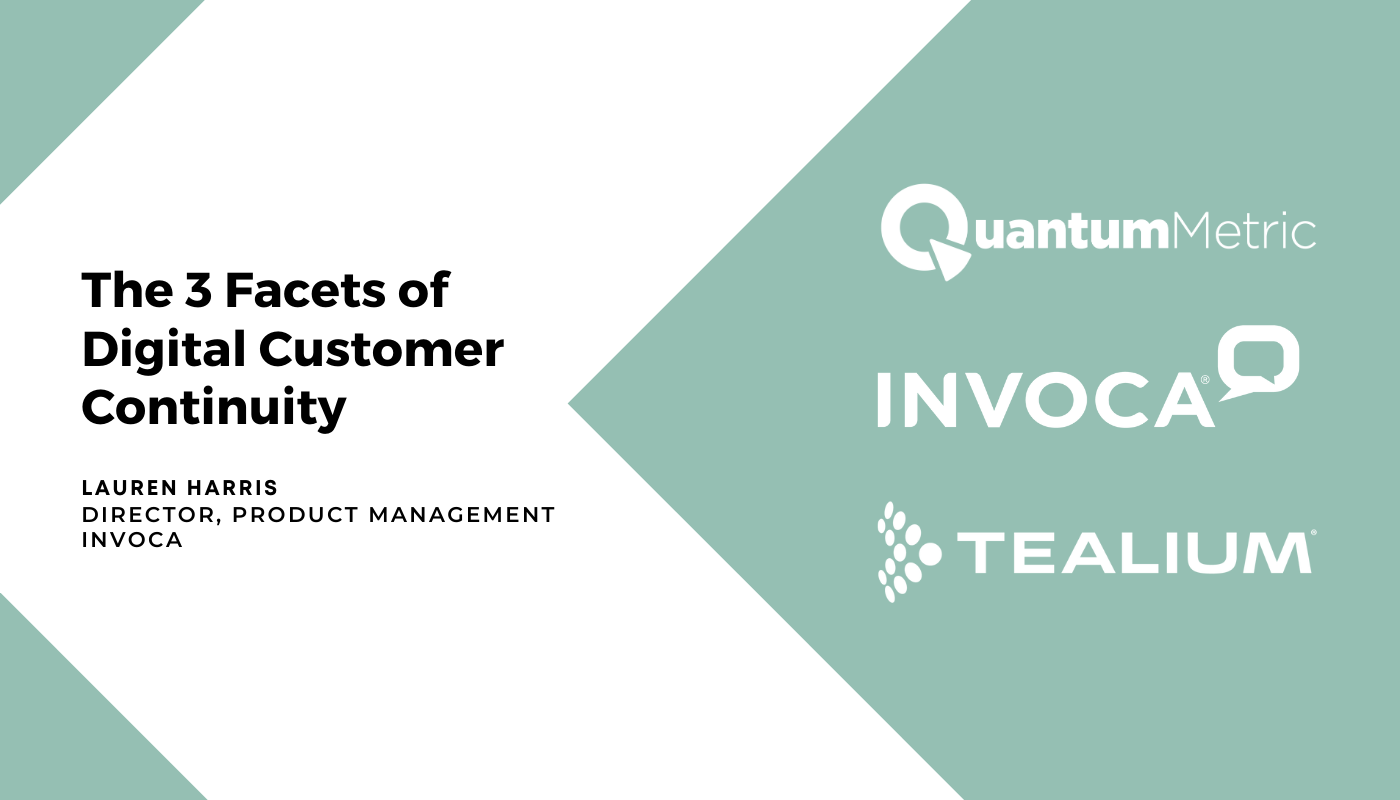The 3 Facets of Digital Customer Continuity

The following post is authored by Lauren Harris, Director, Product Management at Invoca.
I had the privilege of co-presenting a virtual breakout session with Quantum Metric at Tealium’s Digital Velocity conference in early May. As session planning kicked off, my knowledge of Quantum Metric and continuous product design was limited. As I learned more, the power of Quantum Metric’s data and insights became apparent. Further, it had me feeling pretty jazzed about the exponential power when using Quantum Metric, Invoca, and Tealium together.
A big theme that surfaced was how each of our solutions focuses on our customers’ ability to deliver better experiences to their customers. Delivering the best customer experience in-person, digitally, or on the phone is an integral part of making sure your company is capitalizing on every revenue opportunity available and building loyalty to retain the customers you fought so hard to win in the first place.
To that end, if I asked what your customers need to make their experience better right now, would you be able to confidently articulate those needs and answer how you’ll meet them? It’s tough to do!
That’s where technology can play a crucial role.
Real-time visibility into the ‘why’
One of the reasons it can be difficult to properly identify and quantify customer needs has to do with the nature of customer journeys these days. They can appear fragmented as customers jump between devices and go from browsing online to talking on the phone in a matter of clicks. Establishing continuity through all these journey jumps and meandering paths is important in the quest to understand your customers and their needs.
As it relates to tracking customer journeys, there are a few areas that are prone to a lack of visibility. The first I’d like to highlight has to do with how your customers are interacting with your digital properties. Many digital solutions do an amazing job of tracking every impression, every click, every video play, every product added to the cart, and every online conversion. Where they fall short is in illuminating what is actually happening when a customer is spending a lot of time on a particular page. Are they struggling to complete an online purchase? Are they having trouble submitting a form? Are they searching for an answer to a specific question? This is where Quantum Metric can offer up some amazing insights.
Through session replays, it’s possible to see a specific journey and relive the good, the bad, and the ugly. This real-time visibility uncovers conversion blockers, design friction, and true cross-platform experiences. Even better, Quantum Metric calculates the greater impact of each experience, so you can either hone in on the sessions that will help you solve a specific pain point or understand the larger scale of an issue by seeing who else it impacted. That then enables your team to prioritize a solve in your next release.
Bridging the gap between calls and digital
The second area I’d like to highlight is when a customer decides to call your business. The customer may have found your website after a Google search and browsed around different pages. Perhaps they even added a product to the cart, but had trouble checking out. The customer resorts to calling and, after essentially starting from square one, the purchase is finally completed over the phone. This is great, but what isn’t so great is when that customer all of a sudden sees a targeted ad featuring the product they just purchased, at a discount no less!
This is one reason it’s really important to tie what happens on the phone to the digital journey. Believe it or not, this is possible with a call tracking and conversational analytics solution, like Invoca. Invoca is able to link the digital journey, including the marketing channel that led to the call and the page a call was placed from, with the phone call to provide a more complete picture of the customer’s journey.
Further, using AI, Invoca can identify topic clusters that allow you to understand trends across a grouping of calls. This makes it scalable to listen to a subset of calls to confirm the type of call or outcome, which can then serve as a model to tag future calls tracked by the system. For example, this helps our customers break out sales calls, support calls, appointments, voicemails, purchases, and much more.
Completing the customer experience picture
The exponential power in our triumvirate of customer solutions comes into play when combining Quantum Metric and Invoca data in Tealium. Invoca shares call and call conversion data with Tealium’s customer data platform while Quantum Meric shares information like the session replay URL and indicators of frustration. This is where it all comes together, allowing companies to see a call recording alongside a session replay tied to a frustration score and the call outcome to finally understand how an experience went and opportunities for improvement. This makes it possible to track, learn, and iterate in perpetuity to make sure you are staying up to date on customer needs and implementing the changes necessary to deliver the best experience across your customers’ journeys and engagements.
This leads to a noteworthy point. When building your tech stack, it’s imperative to choose solution providers that support your business, but it’s also important to choose solution providers that support each other. This is an effective way to bring complete continuity and visibility into the full customer journey and to benefit from integrations that have been established, with minimal effort required on your part.
Now, as you contemplate your journey to better track your customer needs, take some time to identify any gaps in the analytics you currently have in place. Ask yourself some questions:
- Are you confident you understand if customers are experiencing issues as they navigate your digital properties?
- Are you going beyond counting the number of calls to your business by associating those calls with marketing campaigns and scalably tagging the type of call and call outcome?
- Is there continuity between online and offline experiences?
Once you’ve identified the gaps, that’s a great first step in understanding how you might be able to fill them. Follow the process of continuous product design, which ultimately leads to happier customers and more of the conversions that keep your company going.
Interested in learning more about improving call center outcomes? Check out Five Ways to Improve Digital Self Service and Reduce Call Center Costs.







